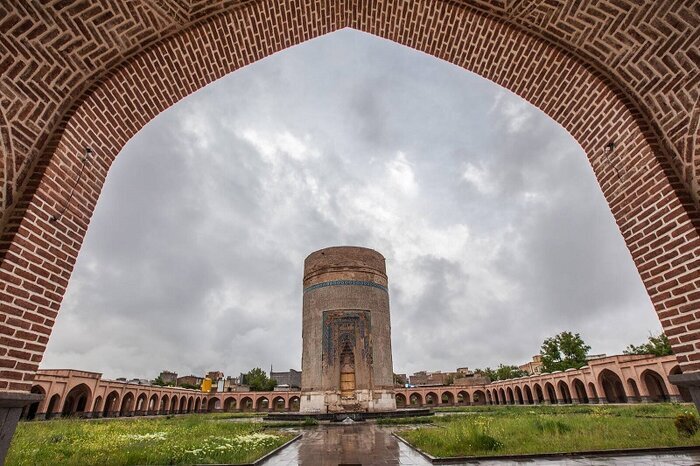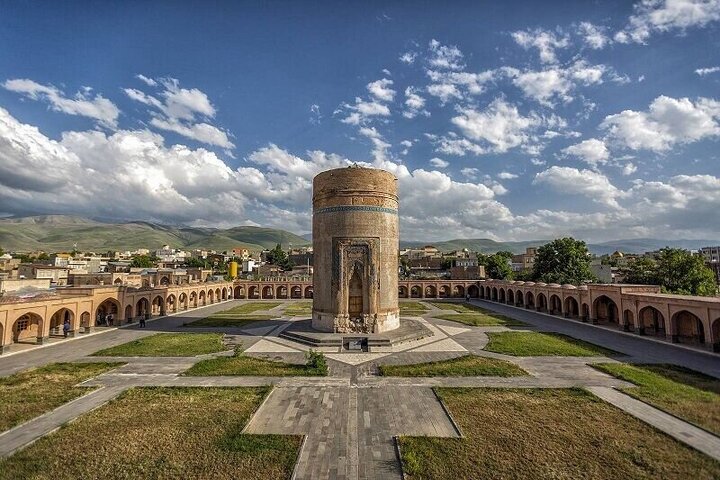Iran (IMNA) -Although in the pre-Islamic period made of brick or stone as well as rock-hewn tombs of kings and great figures were prevalent, in the Islamic period, especially from the Seljuk period, certain tower-shaped or square tombs became common.
The tomb of Sheikh Haider in Meshgin-Shahr is one of these tower tombs, the date of which differing and sometimes conflicting opinions exist. Some sources say many decorations of the tomb tower date back to the Safavid period. Others say that the building dates back to the Ilkhanid period and beyond.
The monument stands tall in the Azarbaijan region of northwestern Iran, which plays an important role in the development of tower tombs.
As mentioned by Visit Iran, Sheikh Heydar, Shiekh Jonayd’s son, was one of the great mystics who showed great courage in the war with Sirvan and was killed in the same war. “His body was transferred to Meshgin Shahr by his disciples, where they constructed a mausoleum for him.”
According to the historical document, Shah Ishmael, the founder of the Safavid Empire, transferred the body of his father, Sheikh Heydar, to the family tomb in Ardabil, next to the tomb of their great ancestor, Sheikh Safi al-Din. Therefore, this mausoleum is now only a reminder of his original burial and not his true tomb. Later, some spaces such as parking lots, a museum, a library, and other facilities for tourists were added to this place.
A destination for sightseers, researchers, and history buffs, the building is in the shape of a cylindrical brick tower and is placed in the old and central structure of Meshgin-Shahr in a green and beautiful garden. It is surrounded by some porches that possibly were once used by passengers to rest.
The tower is 18 meters in height and 10.5 meters in diameter. It has a basement and an upper circular part. The roof is dome-shaped and gabled, but the original roof was also dome-shaped and was destroyed during the war with the Russians.
Although the outside of this tower is circular, its inside has twelve sides, symbolizing the twelve Shia Imams to whom the Safavids were extremely devoted. The entrance door of the basement is on the north side of the building, and the Sheikh's tomb is at the end of it.

The building material was stone for the foundation and brick for the walls. The brick body of this tower has been decorated with beautiful blue tiles from the outside. Although these tiles did not cover the entire body and were broken in some places, they still show their beauty and splendor.
As part of its arabesque decorations, the monument bears the name of “Allah”, believed to be inspired by the dome of Allah Allah in Ardabil, or the same dome of Sheikh Safi al-Din, but the tiles of the Ardabil dome are more readable than those of Sheilk Heydar.
Other sacred worlds, like Hoo, Mohammad (PBUH), and Ali (AS) are also seen on the tiles. The entrance door and three windows of this building , beautiful plaster muqarnas decorations. This tomb tower was nationally registered in 1932.
Some cultural heritage experts believe additions and architectural decorations related to the post-patriarchal period have been added to the tomb tower though the construction date of the building revolves around the middle of the 8th century AH.
There are many historical clues to help determine the origin of these doubts and get a clear answer to all questions.
Tehrantimes
AFM


Your Comment